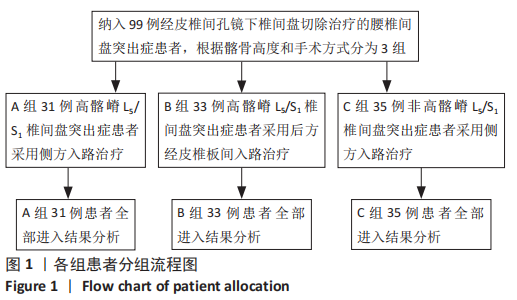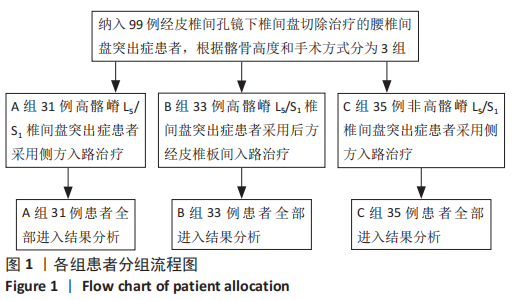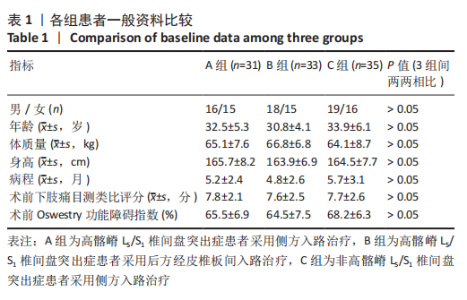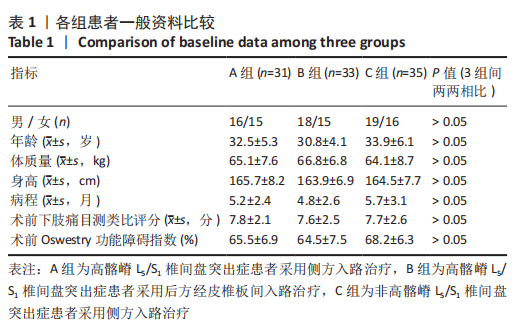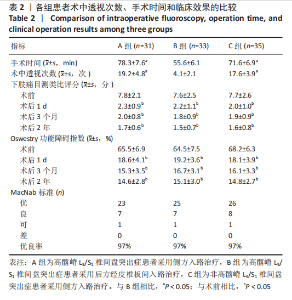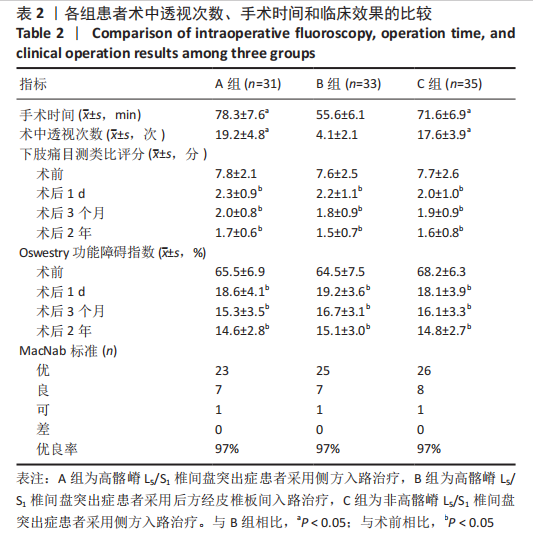[1] CHOI KC, PARK CK. Percutaneous endoscopic lumbar discectomy for L5-S1 disc herniation: consideration of the relation between the iliac crest and L5-S1 disc. Pain Physician. 2016;19(2):E301-308.
[2] YANG JS, LIU KX, KADIMCHERLA P, et al. Can the novel lumboIliac triangle technique based on biplane oblique fluoroscopy facilitate transforaminal percutaneous endoscopic lumbar discectomy for patients with L5-S1 disc herniation combined with high Iliac crest? Case-Control Study of 100 Patients. Pain Physician. 2020;23(3):305-313.
[3] 刘少华,张宏其,段春岳,等. 脊柱内镜椎板间入路治疗高髂嵴L5/S1脱垂型腰椎间盘突出症[J]. 中南大学学报(医学版),2020,45(8): 948-953.
[4] CHEN KT, WEI ST, TSENG C, et al. Transforaminal endoscopic lumbar discectomy for L5-S1 disc herniation with high iliac crest: technical note and preliminary series. Neurospine. 2020;17(Suppl 1):S81-S87.
[5] YAMAGUCHI JT, HSU WK. Intervertebral disc herniation in elite athletes. Int Orthop. 2019;43(4):833-840.
[6] KIM HS, PAUDEL B, JANG JS, et al. Percutaneous endoscopic lumbar discectomy for all types of lumbar disc herniations (LDH) including severely difficult and extremely difficult LDH Cases. Pain Physician. 2018;21(4):E401-E408.
[7] SAIRYO K, CHIKAWA T, NAGAMACHI A. State-of-the-art transforaminal percutaneous endoscopic lumbar surgery under local anesthesia: Discectomy, foraminoplasty, and ventral facetectomy. J Orthop Sci. 2018;23(2):229-236.
[8] PAN M, LI Q, LI S, et al. Percutaneous endoscopic lumbar discectomy: indications and complications. Pain Physician. 2020;23(1):49-56.
[9] TEZUKA F, SAKAI T, ABE M, et al. Anatomical considerations of the iliac crest on percutaneous endoscopic discectomy using a transforaminal approach. Spine J. 2017;17(12):1875-1880.
[10] 刘丰平, 赵红卫, 董军峰, 等. 后外侧入路椎间孔镜下L5/S1椎间盘突出伴高髂嵴髓核摘除术的技术改进[J]. 中国微创外科杂志, 2019,19(2):101-105.
[11] KONG W, CHEN T, YE S, et al. Treatment of L5 - S1 intervertebral disc herniation with posterior percutaneous fullendoscopic discectomy by grafting tubes at various positions via an interlaminar approach. BMC Surg. 2019;19(1):124.
[12] RUETTEN S, KOMP M, GODOLIAS G. A new full endoscopic technique for the interlaminar operation of lumbar disc hemiations using 6-mm endoscopes:prospective 2-year results of 331 patients. Minim Invasive Neurosurg. 2006;49(2):80-87.
[13] 黄泽楠, 张亮, 张志强, 等. 经皮椎板间入路与椎间孔入路椎间孔镜下髓核摘除术治疗L5/S1椎间盘突出症的疗效分析[J]. 中国医师杂志,2018,20(4):507-516.
[14] LEE JS, KIM HS, PEE YH, et al. Comparison of Percutaneous Endoscopic Lumbar Diskectomy and Open Lumbar Microdiskectomy for Recurrent Lumbar Disk Herniation. J Neurol Surg A Cent Eur Neurosurg. 2018; 79(6):447-452.
[15] RUETTEN S, KOMP M, MERK H, et al. Recurrent lumbar disc herniation after conventional discectomy: a prospective, randomized study comparing full-endoscopic interlaminar and transforaminal versus microsurgical revision. J Spinal Disord Tech. 2009;22(2):122-129.
[16] YEUNG AT, TSOU PM. Posterolateral endoscopic excision for lumbar disc hemiation: sugical technique,outcome,and complications in 307 consecutive cases. Spine(Phila Pa 1976). 2002;27(7):722-731.
[17] HOOGLAND T, SCHUBERT M, MIKLITZ B, et al. Transforaminal posterolateral endoscopic discectomy with or without the combination of a low-dose chymopapain: a prospective randomized study in 280 consecutive cases. Spine (Phila Pa 1976). 2006;31(24):E890-E897.
[18] 魏亮,王玉晶,戴琎,等. 椎间孔镜BEIS技术治疗腰椎间盘突出症的临床疗效[J]. 中国矫形外科杂志,2019,27(19):1806-1808.
[19] 周跃,李长青,王建,等. 椎间孔镜YESS 与TESSYS 技术治疗腰椎间盘突出症[J]. 中华骨科杂志,2010,30(3):225-231.
[20] CHOI G,LEE SH,RAITURKER PP, et al. Percutaneous endoscopic interlaminar discectomy for intracanalicular disc herniations at L5S1 using a rigid working channel endoscope. Neurosurgery. 2006; 58(1 Suppl):59-68.
[21] RUETTEN S, KOMP M, MERK H, et al. Full-endoscopic interlaminar and transforaminal lumbar discectomy versus conventional microsurgical technique: a prospective, randomized, controlled study. Spine (Phila Pa 1976). 2008;33(9):931-939.
[22] 李宁 ,黄良诚, 车路阳, 等.髂嵴高度对经皮内镜椎间孔入路治疗L5-S1椎间盘突出症的影响[J]. 解放军医学院学报,2017,38(6):527-530.
[23] 刘继波, 李江龙, 周鹏, 等. 侧路椎间孔镜下治疗高髂嵴L5/S1椎间盘突出症的手术技巧及疗效观察[J]. 海南医学,2018,29(1):107-109.
[24] 翟云雷, 于海洋, 王康康, 等. 经椎板间隙入路椎间孔镜下治疗高髂嵴连线L5-S1椎间盘突出症[J]. 临床骨科杂志,2019,22(4):397-403.
[25] 张为, 王亚朋, 安纪龙, 等. 经髂骨入路椎间孔镜下髓核摘除术治疗椎间盘突出症[J]. 医学信息,2016,29(17):256-257.
[26] WANG Z, CHEN Z, WU H, et al. Treatment of high-iliac-crest L5-S1 lumbar disc herniation via a transverse process endoscopic transforaminal approach. Clin Neurol Neurosurg. 2020;197:106087.
[27] AO S, WU J, TANG Y, et al. Percutaneous endoscopic lumbar discectomy assisted by O-arm-based navigation improves the learning curve. Biomed Res Int. 2019;6509409:1-10.
[28] ABUDUREXITI T, QI L, MUHEREMU A, et al. Micro-endoscopic discectomy versus percutaneous endoscopic surgery for lumbar disk herniation. J Int Med Res. 2018;46(9):3910-3917.
[29] ZHOU C, ZHANG G, PANCHAL RR, et al. Unique Complications of Percutaneous Endoscopic Lumbar Discectomy and Percutaneous Endoscopic Interlaminar Discectomy. Pain Physician. 2018;21(2): E105-E112.
[30] CHOI G, KIM JS, LOKHANDE P, et al. Percutaneous endoscopic lumbar discectomy by transiliac approach: A case report. Spine (Phila Pa 1976). 2009;34(12):E443-E446.
[31] 张宽, 楚磊, 陈亮, 等. 经皮内镜髂骨入路治疗L5/S1椎间盘突出症[J]. 中华创伤杂志,2015,31(10):882-884.
|
